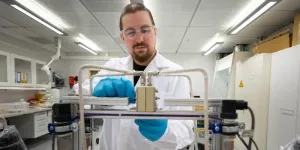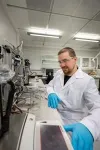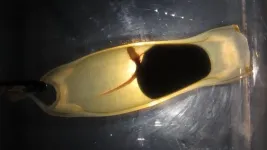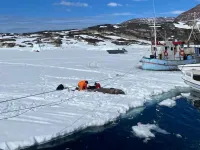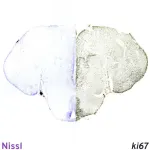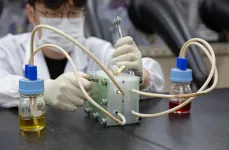(Press-News.org) Norway wastes huge amounts of energy. Surplus heat produced by industry is hardly exploited at all.
Researchers at the Norwegian University of Science and Technology (NTNU) have been looking at the possibilities for doing something about this.
“Surplus heat from industrial processes is a huge resource,” says Kim Kristiansen.
He has just completed his PhD on a technology that can harness some of the surplus heat that currently goes to waste. Almost all the heat generated by industrial processes is currently released directly into the air or the ocean, and we are not talking about small amounts. In Norway alone, industry produces around 20 TWh of waste heat each year.
That number might not mean much to you, but according to the Norwegian Water Resources and Energy Directorate (NVE), this amount of energy corresponds to half of the electricity consumption of all Norwegian households combined. In other words, approximately the entire heating demand.
Kristiansen is part of the thermodynamics research group at PoreLab in the Department of Chemistry. Academic supervisor Signe Kjelstrup and research group manager Øivind Wilhelmsen are co-authors of the articles in question.
Drinking water as an added bonus
The technology also has another effect that may not be as relevant in Norway, but which might be a game changer in countries with limited drinking water.
“The technology doesn’t just recycle the waste heat energy, it can also purify the waste water produced by industry,” says Kristiansen.
In many parts of the world, drinking water is becoming an increasingly scarce resource.
“According to UNICEF, four billion people are already experiencing severe drinking water shortages for at least one month of the year, and there is a high demand for technology that can meet these challenges,” says Kristiansen.
A lack of drinking water is therefore a problem for approximately half of the world’s eight billion people.
Producing clean water
So what is this new technology?
“The waste water produced by industry is often contaminated. If we evaporate this impure water through small pores in a water-repellent membrane, the condensed water that emerges on the other side is drinkable,” says Kristiansen.
This method is best suited for purifying water with so-called non-volatile impurities, such as salt. This is in contrast to alcohols and a number of other organic substances that can evaporate along with the water through the membrane.
“The most important area of application for this technology is therefore desalination of seawater. The treatment of process water is not being ruled out, but it involves additional challenges depending on its content,” says Kristiansen.
So, the technology can produce drinking water, but what about exploiting the waste energy?
Exploiting temperature differences to pump up water
When water is heated on one side of the membrane, it evaporates and releases heat on the other side through condensation. A pressure difference may then arise between the two sides of the membrane
“The temperature difference is used to pump the water up, and the pressure difference represents mechanical energy that can be used to power a turbine,” says Kristiansen. The phenomenon is called thermal osmosis.
Seemingly simple, but ingenious.
“We have investigated the interactions between water and the pores in the membrane, and what happens when the water evaporates, is transported through the pores, and condenses,” says Kristiansen about the doctoral research.
He has designed theories on membrane properties and the effect they have on the entire process. He has also systematically measured this effect in the laboratory.
“The conclusion is that the technology has great potential. Through modification of the membranes, we can help address both the increasing challenges associated with energy efficiency requirements and the lack of clean drinking water,” says Kristiansen.
A Dutch idea
Kristin Syverud at the RISE PFI research institute is interested in improving the membranes used in this technology.
“The starting point for the work was an idea that TNO in the Netherlands gets the credit for,” says Kristiansen’s academic supervisor Signe Kjelstrup.
She is Professor Emerita and former Head Researcher at PoreLab – Centre of Excellence. TNO is an independent institute that works to translate research findings into real-life applications.
TNO experimented with the concept called ‘MemPower’ (simultaneous production of water and power) and the prototype was made at their facilities. The researchers wanted to collaborate but had no funding. The solution was to continue the project as open research at NTNU.
“Leen van der Ham from TU Delft got in touch with me and I introduced the idea to the group I then had at the Department of Chemistry, and later at PoreLab.”
Van der Ham took his PhD in Chemistry at NTNU a few years ago, which shows just how important it is to have contacts. They worked with Luuk Keulen, a student at TU Delft, and the research was continued by Kristiansen and Michael Rauter from PoreLab.
Practical challenges
“Industry is showing interest in the concept of membrane distillation, but so far, there are only a few pilot plants worldwide,” says Kristiansen.
The main reason industry is lagging behind academia is related to practical challenges associated with membrane technology, he explains. For example, this applies to the lifespan of membranes under harsh industrial conditions.
“A lot of work is being done internationally in both academia and industry to meet these challenges and commercialise the technology,” says Kristiansen.
The MemPower concept involves converting waste heat into mechanical energy based on differences in temperature.
“My impression is that industry is not yet fully aware of this concept and the opportunity it offers,” says Kristiansen.
One of the conclusions in the latest article is that the potential for energy production is competitive in relation to more established membrane-based energy processes. He believes this could help increase commercial interest.
Reference: Kristiansen, Kim and Wilhelmsen, Oivind and Kjelstrup, Signe, Thermo-Osmotic Coefficients in Membrane Distillation experiments and Theory for Three Types of Membranes. Desalination, Volume 586, 2024, 117785, ISSN 0011-9164, https://doi.org/10.1016/j.desal.2024.117785
END
How to avoid wasting huge amounts of energy
Surplus heat from industry is a underused resource that can be used to purify some types of industry wastewater while providing heat to homes and businesses
2024-07-03
ELSE PRESS RELEASES FROM THIS DATE:
Bowel cancer turns genetic switches on and off to outwit the immune system
2024-07-03
Bowel cancer cells have the ability to regulate their growth using a genetic on-off switch to maximise their chances of survival, a phenomenon that’s been observed for the first time by researchers at UCL and University Medical Center Utrecht.
The number of genetic mutations in a cancer cell was previously thought to be purely down to chance. But a new study, published in Nature Genetics, has provided insights into how cancers navigate an “evolutionary balancing act”.
The researchers found that mutations in DNA repair genes can be repeatedly created and repaired, acting as ‘genetic switches’ that take the brakes off a tumour’s growth ...
Shark hatching success drops from 82% to 11% in climate change scenario
2024-07-03
New experimental research shows that the combined effects of ocean warming and acidification could lead to a catastrophic decrease in embryonic shark survival by the year 2100. This research is also the first to demonstrate that monthly temperature variation plays a prominent role in shark embryo mortality.
Oceanic warming and acidification are caused by greater concentrations of CO2 dissolving into marine environments, resulting in rising water temperatures and falling pH levels. “The embryos of egg-laying ...
Meet the team 3D modelling France’s natural history collections
2024-07-03
France’s natural history collections contain nearly 6% of the world’s total natural specimens across multiple institutions, and the e-COL+ project aims to capture and reconstruct these specimens in 3D for easy access and 3D printing around the world.
“I’m a researcher of vertebrate locomotion and vocalisation, so I produce a lot of CT scans and 3D models – and now I’m in charge of developing the museum’s own 3D digital collection,” ...
Artificial light is a deadly siren song for young fish
2024-07-03
New research finds that artificial light at night (ALAN) attracts larval fish away from naturally lit habitats, while dramatically lowering their chances of survival in an “ecological trap”, with serious consequences for fish conservation and fishing stock management.
“Light pollution is a huge ongoing subject with many aspects that are still not well understood by scientists,” says Mr Jules Schligler, a PhD student at CRIOBE Laboratory (Centre de Recherches Insulaires et Observatoire de l’Environnement) in Moorea, French Polynesia.
ALAN is the product of human-related ...
Social media is a likely cause of ‘confusion’ in modern mate selection
2024-07-03
A recent sociological study finds that most young adults surveyed reported feeling confused about their options when it comes to dating decisions. Preliminary analysis suggests that more than half of young people experience confusion about choosing life-partners, with women appearing to be more likely to report partner selection confusion than men.
Due to the pervasiveness of social media and digital dating in everyday lives, humans are now exposed to many more potential mates than ever before, but the availability of popular dating apps ...
Exploring bird breeding behaviour and microbiomes in the radioactive Chornobyl Exclusion Zone
2024-07-03
New research finds surprising differences in the diets and gut microbiomes of songbirds living in the radiation contaminated areas of the Chornobyl Exclusion Zone, Ukraine. This study is also the first to examine the breeding behaviour and early life of birds growing up in radiologically contaminated habitats.
The Chornobyl Exclusion Zone (Ukrainian), also known as the Chernobyl Exclusion Zone (Russian), is an area of approximately 2,600 km2 of radiologically contaminated land that surrounds the Chornobyl Nuclear Power Plant. The levels of contamination are uneven throughout the zone.
“The ...
Discovering new anti-aging secrets from the world’s longest-living vertebrate
2024-07-03
New experimental research shows that muscle metabolic activity may be an important factor in the incredible longevity of the world’s oldest living vertebrate species – the Greenland shark. These findings may have applications for conservation of this vulnerable species against climate change or even for human cardiovascular health.
Greenland sharks (Somniosus microcephalus) are the longest living vertebrate with an expected lifespan of at least 270 years and possible lifespan beyond 500 years. “We want to understand what adaptations ...
Pregnant fish can also get “baby brain”, but not the way that mammals do
2024-07-03
New research reveals that pregnancy-related brain impairment is present in live-bearing fish, but instead of affecting learning and memory as expected from similar research on mammals, it appears to have a stronger impact on decision-making and sensory reception.
There have been many studies into the detrimental impact of pregnancy on mammalian brains, sometimes called “baby brain” or “momnesia” in humans, revealing how the disruption of neurological processes like neurogenesis, or the creation ...
Pasteurization inactivates highly infectious avian flu in milk
2024-07-03
Highlights:
• In late March 2024, H5N1 bird flu was detected in dairy cattle and then in raw milk.
• Researchers tested hundreds of milk products from dozens of states for the virus.
• No infectious virus was found in pasteurized milk products.
• Non-infectious traces of viral genetic material were found in 20% of samples.
Washington, D.C.—In March 2024, dairy cows in Texas were found to be infected with highly pathogenic avian flu, ...
KIER develops 'viologen redox flow battery' to replace vanadium’
2024-07-03
A technology has been developed to replace the active material in large-capacity ESS 'redox flow batteries' with a more affordable substance.
*Redox Flow Battery: A term synthesized from Reduction, Oxidation, and Flow. It is a battery that stores electrical energy as chemical energy through oxidation and reduction reactions of active materials in the electrolyte at the electrode surface and converts it back to electrical energy when needed. It is capable of large-scale storage, can be used long-term through periodic replacement of the electrolyte, and its major advantage is the absence of fire risk.
Dr. Seunghae Hwang’s ...
LAST 30 PRESS RELEASES:
Microplastics detected in rural woodland
JULAC and Taylor & Francis sign open access agreement to boost the impact of Hong Kong research
Protecting older male athletes’ heart health
KAIST proposes AI-driven strategy to solve long-standing mystery of gene function
Eye for trouble: Automated counting for chromosome issues under the microscope
The vast majority of US rivers lack any protections from human activities, new research finds
Ultrasound-responsive in situ antigen "nanocatchers" open a new paradigm for personalized tumor immunotherapy
Environmental “superbugs” in our rivers and soils: new one health review warns of growing antimicrobial resistance crisis
Triple threat in greenhouse farming: how heavy metals, microplastics, and antibiotic resistance genes unite to challenge sustainable food production
Earthworms turn manure into a powerful tool against antibiotic resistance
AI turns water into an early warning network for hidden biological pollutants
Hidden hotspots on “green” plastics: biodegradable and conventional plastics shape very different antibiotic resistance risks in river microbiomes
Engineered biochar enzyme system clears toxic phenolic acids and restores pepper seed germination in continuous cropping soils
Retail therapy fail? Online shopping linked to stress, says study
How well-meaning allies can increase stress for marginalized people
Commercially viable biomanufacturing: designer yeast turns sugar into lucrative chemical 3-HP
Control valve discovered in gut’s plumbing system
George Mason University leads phase 2 clinical trial for pill to help maintain weight loss after GLP-1s
Hop to it: research from Shedd Aquarium tracks conch movement to set new conservation guidance
Weight loss drugs and bariatric surgery improve the body’s fat ‘balance:’ study
The Age of Fishes began with mass death
TB harnesses part of immune defense system to cause infection
Important new source of oxidation in the atmosphere found
A tug-of-war explains a decades-old question about how bacteria swim
Strengthened immune defense against cancer
Engineering the development of the pancreas
The Journal of Nuclear Medicine ahead-of-print tip sheet: Jan. 9, 2026
Mount Sinai researchers help create largest immune cell atlas of bone marrow in multiple myeloma patients
Why it is so hard to get started on an unpleasant task: Scientists identify a “motivation brake”
Body composition changes after bariatric surgery or treatment with GLP-1 receptor agonists
[Press-News.org] How to avoid wasting huge amounts of energySurplus heat from industry is a underused resource that can be used to purify some types of industry wastewater while providing heat to homes and businesses
